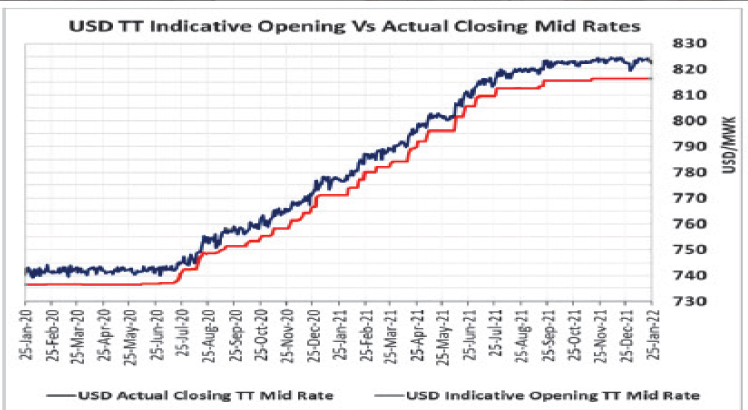EIU projects 3% kwacha fall
The kwacha may depreciate further by about three percent against other trading currencies this year through 2026 largely due to widening current account deficit, the Economist Intelligence Unit (EIU) has projected.
According to the EIU forecast contained in the annual economic report by Nico Asset Managers Limited, the average value of the kwacha is, therefore, expected to weaken from the current K823 to the dollar to K847.69 to the dollar.
Said the firm: “The EIU expects that the kwacha will depreciate further as the large current account deficit will exert downward pressure on the kwacha throughout the forecast period.”

The forecast by EIU—a firm within the Economist Group which provides forecasting and advisory services—comes at a time the kwacha has continued to face pressure as it has depreciated throughout the just ended year.
Such a volatile exchange rate throughout 2021 left the country grappling with higher costs and weaker consumer demand.
The depreciation of the local currency also did more harm to an ordinary consumer as it exacerbated inflationary pressures, pushing up prices of basic goods and services.
The current account deficit averaged just under 19 percent of gross domestic product (GDP) on account of a large merchandise trade deficit, owing to Malawi’s dependence on fuel and capital imports, according to the EIU data.
The country’s current account deficit stood at $1.4 billion (K1.15 trillion), representing 12.7 percent of the GDP due to worsening of the goods account by 3.1 percent to $1.78 billion (K1.46 trillion).
Meanwhile, Reserve Bank of Malawi (RBM) has also projected continued pressure on the kwacha on account of excess demand on the market for foreign exchange against supply.
RBM Governor Wilson Banda is on record saying the central bank is looking at arranging facilities with regional and international banks to provide the country with short liquidity in foreign currency thus stabilising the kwacha.
Market analyst Cosmas Chigwe observed in an interview yesterday that the kwacha depreciation is expected as structural problems on the supply side continue to persist.
He said: “We continue to have a deficit between supply and demand of foreign exchange and the kwacha will continue responding to this. There will always be negative pressure on the direction of currency as long as the balance of payments remains negative. This would thus continue to put pressure on the kwacha to depreciate.”
Financial Market Dealers Association of Malawi (Fimda) president MclewenSikwesealso observed that the kwacha continues to suffer from both supply and demand misalignment, but also a speculative element due to the lack of confidence in the future value of the local currency.
“The country, therefore, needs to build liquid foreign exchange reserves of import cover position and using them to supply the foreign exchange market with foreign currency,” he said.
In 2021, the kwacha depreciated by 5.91 percent, closing at K816.40 to the dollar compared to K770.84 to the dollar registered in 2020.
The downward trend was mainly attributed to a decline in foreign exchange supply which in turn put pressure on the country’s foreign exchange reserves.
During this period, gross official forex reserves under the direct control of the RBM dropped from $502.98 million, an equivalent of 2.41 months of imports in January 2021 to 429.17 million, an equivalent of 1.72 months of imports in December 2021.





